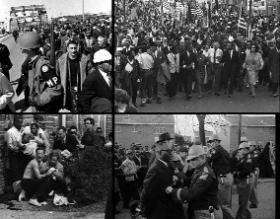Selma and Burntollet: similarities and contrasts
Published in 20th-century / Contemporary History, Features, Issue 5 (Sep/Oct 2008), Troubles in Northern Ireland, Volume 16
Scenes from the Edmund Pettus Bridge, Selma, Alabama, March 1965—‘Our march was based upon the Selma–Montgomery “freedom march”.’
Our march was based upon the Selma–Montgomery ‘freedom march’ in Alabama in 1965, and it is instructive to examine the similarities and the contrasts. The distance between the two US cities, at 55 miles, was quite a bit shorter than ours. The march, like ours, was organised by a student group, the Student Non-Violent Co-ordinating Committee. While it had more initial participants than ours (it could hardly have had fewer), at less than 600 its numbers were unimpressive. We managed to reach our target within our timetable of four days, in spite of increasingly violent attacks. The Alabama march took nearly three weeks. It began on 7 March 1965 but was attacked and turned back by state police. On 9 March a second march, this time headed by Revd Martin Luther King Jnr and other religious leaders, was also stopped by state authority. It was only permitted to proceed, with a National Guard escort, after a federal judicial review, and on 25 March 25,000 marchers arrived at their goal, the Alabama state capital at Montgomery.
Even the experiences and responses are chillingly similar. ‘I was hit on the head by a state trooper with a night stick’, recalled march organiser John Lewis. ‘I thought I saw death.’ One student on our march recounted his experience of the attack at Burntollet Bridge:
‘I was halfway across the bridge . . . when I was struck from behind on the head with a baton or an iron bar. I was badly stunned and fell, but fought to stay conscious because I was afraid of what would happen.’
Yet at the level of government response the contrast could not have been sharper: bitter criticism of the march from the Northern Ireland regime, and silence from the UK government. Speaking shortly after the Selma march, President Johnson said:
‘In Selma, Alabama, long-suffering men and women peacefully protested the denial of their rights as Americans. Many were brutally assaulted. One good man, a man of God, was killed . . . There is no Negro problem. There is no Southern problem. There is only an American problem.’
To underline his sympathy with the movement as a whole, his speech included the phrase: ‘And we shall overcome’.
















